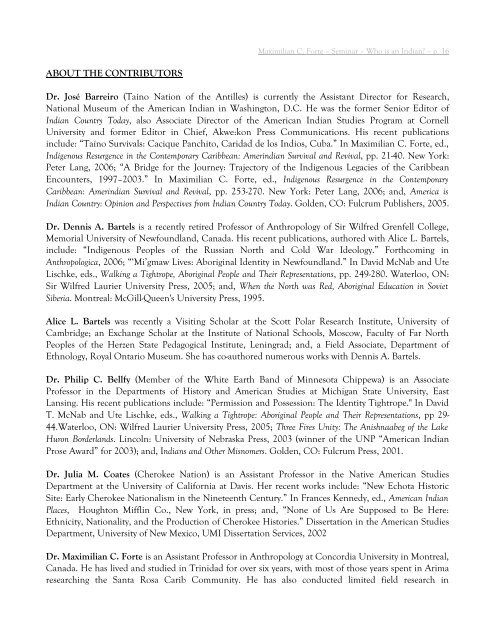Who Is An Indian: Race, Blood, DNA, and the Politics of Indigeneity in the Americas
by Dr. Maximilian C. Forte
by Dr. Maximilian C. Forte
Create successful ePaper yourself
Turn your PDF publications into a flip-book with our unique Google optimized e-Paper software.
Maximilian C. Forte – Sem<strong>in</strong>ar – <strong>Who</strong> is an <strong>Indian</strong>? – p. 16<br />
ABOUT THE CONTRIBUTORS<br />
Dr. José Barreiro (Taíno Nation <strong>of</strong> <strong>the</strong> <strong>An</strong>tilles) is currently <strong>the</strong> Assistant Director for Research,<br />
National Museum <strong>of</strong> <strong>the</strong> American <strong>Indian</strong> <strong>in</strong> Wash<strong>in</strong>gton, D.C. He was <strong>the</strong> former Senior Editor <strong>of</strong><br />
<strong>Indian</strong> Country Today, also Associate Director <strong>of</strong> <strong>the</strong> American <strong>Indian</strong> Studies Program at Cornell<br />
University <strong>and</strong> former Editor <strong>in</strong> Chief, Akwe:kon Press Communications. His recent publications<br />
<strong>in</strong>clude: “Taíno Survivals: Cacique Panchito, Caridad de los Indios, Cuba.” In Maximilian C. Forte, ed.,<br />
Indigenous Resurgence <strong>in</strong> <strong>the</strong> Contemporary Caribbean: Amer<strong>in</strong>dian Survival <strong>and</strong> Revival, pp. 21-40. New York:<br />
Peter Lang, 2006; “A Bridge for <strong>the</strong> Journey: Trajectory <strong>of</strong> <strong>the</strong> Indigenous Legacies <strong>of</strong> <strong>the</strong> Caribbean<br />
Encounters, 1997–2003.” In Maximilian C. Forte, ed., Indigenous Resurgence <strong>in</strong> <strong>the</strong> Contemporary<br />
Caribbean: Amer<strong>in</strong>dian Survival <strong>and</strong> Revival, pp. 253-270. New York: Peter Lang, 2006; <strong>and</strong>, America is<br />
<strong>Indian</strong> Country: Op<strong>in</strong>ion <strong>and</strong> Perspectives from <strong>Indian</strong> Country Today. Golden, CO: Fulcrum Publishers, 2005.<br />
Dr. Dennis A. Bartels is a recently retired Pr<strong>of</strong>essor <strong>of</strong> <strong>An</strong>thropology <strong>of</strong> Sir Wilfred Grenfell College,<br />
Memorial University <strong>of</strong> Newfoundl<strong>and</strong>, Canada. His recent publications, authored with Alice L. Bartels,<br />
<strong>in</strong>clude: “Indigenous Peoples <strong>of</strong> <strong>the</strong> Russian North <strong>and</strong> Cold War Ideology.” Forthcom<strong>in</strong>g <strong>in</strong><br />
<strong>An</strong>thropologica, 2006; “‘Mi’gmaw Lives: Aborig<strong>in</strong>al Identity <strong>in</strong> Newfoundl<strong>and</strong>.” In David McNab <strong>and</strong> Ute<br />
Lischke, eds., Walk<strong>in</strong>g a Tightrope, Aborig<strong>in</strong>al People <strong>and</strong> Their Representations, pp. 249-280. Waterloo, ON:<br />
Sir Wilfred Laurier University Press, 2005; <strong>and</strong>, When <strong>the</strong> North was Red, Aborig<strong>in</strong>al Education <strong>in</strong> Soviet<br />
Siberia. Montreal: McGill-Queen's University Press, 1995.<br />
Alice L. Bartels was recently a Visit<strong>in</strong>g Scholar at <strong>the</strong> Scott Polar Research Institute, University <strong>of</strong><br />
Cambridge; an Exchange Scholar at <strong>the</strong> Institute <strong>of</strong> National Schools, Moscow, Faculty <strong>of</strong> Far North<br />
Peoples <strong>of</strong> <strong>the</strong> Herzen State Pedagogical Institute, Len<strong>in</strong>grad; <strong>and</strong>, a Field Associate, Department <strong>of</strong><br />
Ethnology, Royal Ontario Museum. She has co-authored numerous works with Dennis A. Bartels.<br />
Dr. Philip C. Bellfy (Member <strong>of</strong> <strong>the</strong> White Earth B<strong>and</strong> <strong>of</strong> M<strong>in</strong>nesota Chippewa) is an Associate<br />
Pr<strong>of</strong>essor <strong>in</strong> <strong>the</strong> Departments <strong>of</strong> History <strong>and</strong> American Studies at Michigan State University, East<br />
Lans<strong>in</strong>g. His recent publications <strong>in</strong>clude: “Permission <strong>and</strong> Possession: The Identity Tightrope." In David<br />
T. McNab <strong>and</strong> Ute Lischke, eds., Walk<strong>in</strong>g a Tightrope: Aborig<strong>in</strong>al People <strong>and</strong> Their Representations, pp 29-<br />
44.Waterloo, ON: Wilfred Laurier University Press, 2005; Three Fires Unity: The <strong>An</strong>ishnaabeg <strong>of</strong> <strong>the</strong> Lake<br />
Huron Borderl<strong>and</strong>s. L<strong>in</strong>coln: University <strong>of</strong> Nebraska Press, 2003 (w<strong>in</strong>ner <strong>of</strong> <strong>the</strong> UNP “American <strong>Indian</strong><br />
Prose Award” for 2003); <strong>and</strong>, <strong>Indian</strong>s <strong>and</strong> O<strong>the</strong>r Misnomers. Golden, CO: Fulcrum Press, 2001.<br />
Dr. Julia M. Coates (Cherokee Nation) is an Assistant Pr<strong>of</strong>essor <strong>in</strong> <strong>the</strong> Native American Studies<br />
Department at <strong>the</strong> University <strong>of</strong> California at Davis. Her recent works <strong>in</strong>clude: “New Echota Historic<br />
Site: Early Cherokee Nationalism <strong>in</strong> <strong>the</strong> N<strong>in</strong>eteenth Century.” In Frances Kennedy, ed., American <strong>Indian</strong><br />
Places, Houghton Miffl<strong>in</strong> Co., New York, <strong>in</strong> press; <strong>and</strong>, “None <strong>of</strong> Us Are Supposed to Be Here:<br />
Ethnicity, Nationality, <strong>and</strong> <strong>the</strong> Production <strong>of</strong> Cherokee Histories.” Dissertation <strong>in</strong> <strong>the</strong> American Studies<br />
Department, University <strong>of</strong> New Mexico, UMI Dissertation Services, 2002<br />
Dr. Maximilian C. Forte is an Assistant Pr<strong>of</strong>essor <strong>in</strong> <strong>An</strong>thropology at Concordia University <strong>in</strong> Montreal,<br />
Canada. He has lived <strong>and</strong> studied <strong>in</strong> Tr<strong>in</strong>idad for over six years, with most <strong>of</strong> those years spent <strong>in</strong> Arima<br />
research<strong>in</strong>g <strong>the</strong> Santa Rosa Carib Community. He has also conducted limited field research <strong>in</strong>


















